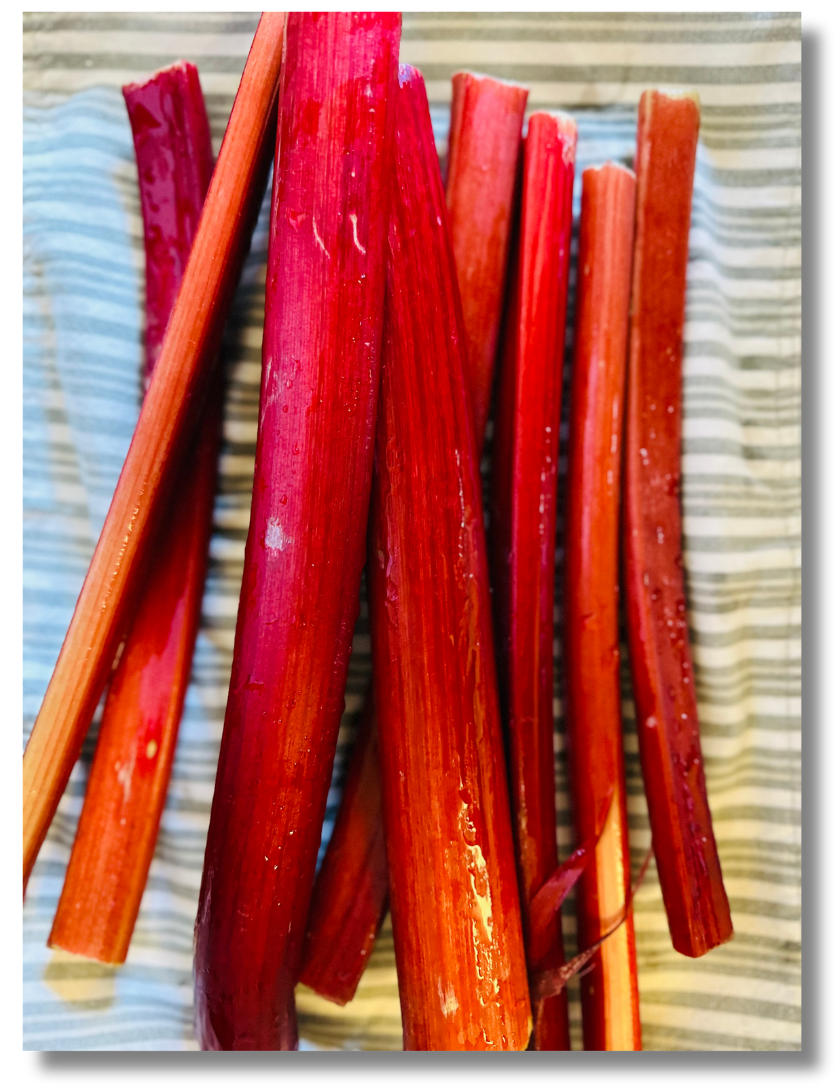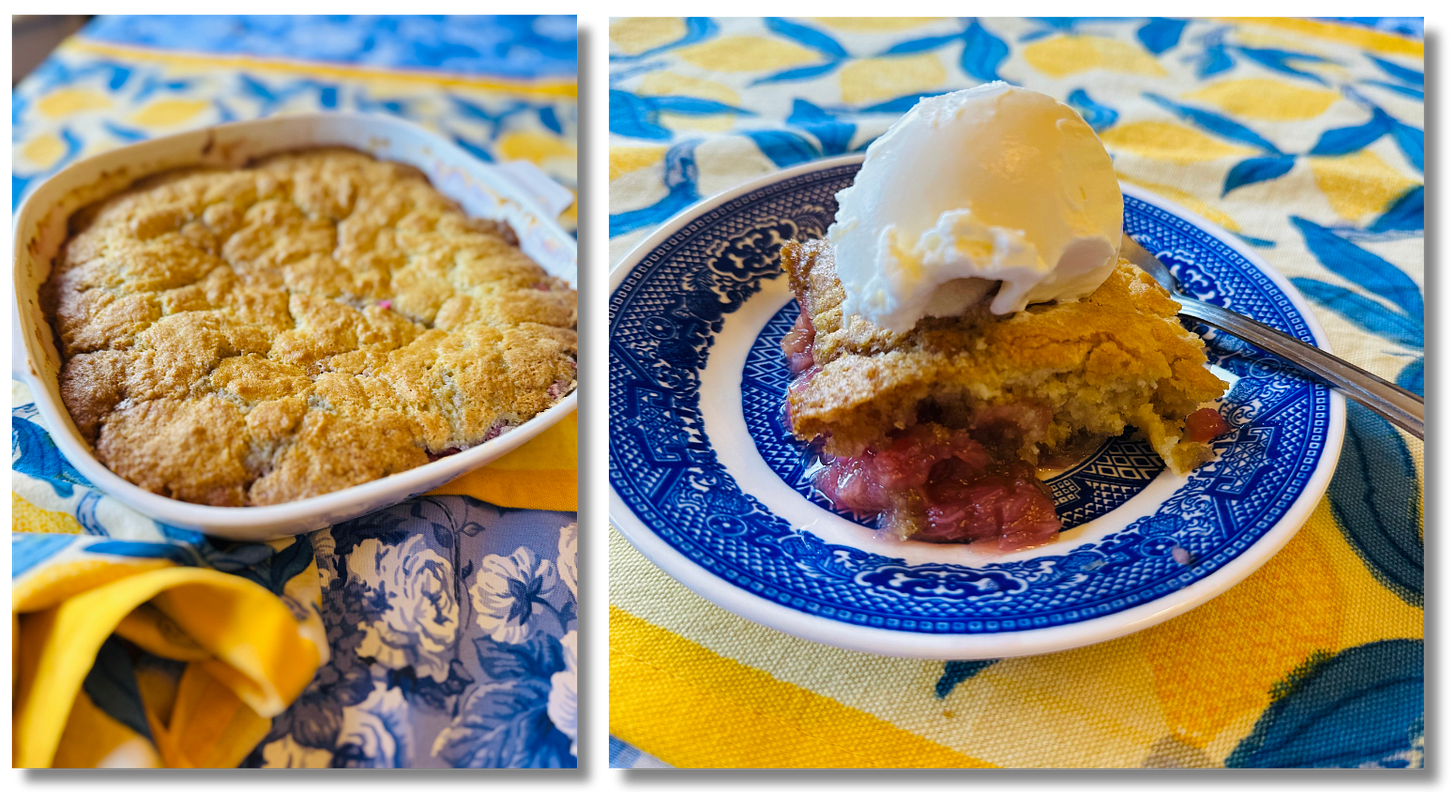When I came across this tiny recipe, it truly felt like a secret message tucked into Estella’s archive.
Barely 1” by 3”, it is the smallest recipe in her collection. Handwritten and untitled, it is just a list of ingredients on one side and brief instructions on the back.

I can imagine her pulling a scrap of paper from her purse and jotting the recipe down quickly at a church luncheon or a friend’s kitchen table. Estella couldn’t resist the promise of a new recipe. Many of her notes name the recipe’s giver—a neighbor, a sister-in-law, a club member—but not this one.
This tiny list and method for a rhubarb cobbler simply whispered bake me.
I’ll admit rhubarb and I are not old friends. I set off to my local market, hoping to find some and learn as I went. The grocer pointed me toward a beautiful display, and there I met a fellow rhubarb shopper who kindly gave me a quick lesson: look for firm, ruby-red stalks; avoid the green; and always remember the leaves are poisonous.
Armed with new knowledge and a bundle of stalks, I headed home with no real sense of how many stalks would make “3 cups diced,” as Estella’s recipe called for.
I did more research and found that for Estella, rhubarb was likely a backyard staple. Hardy and resilient, it thrives in Eastern Washington’s cold winters and wet springs, often offering one of the first harvests of the season. In an era before year-round produce aisles, rhubarb was a prized early “fruit,” though technically a vegetable. Its tart stalks found their way into pies, crisps, jams, and simple cobblers like the one this tiny recipe preserved.
Bake in my kitchen, I pulled out a 9.5” square pan (close enough to the 8”x12” pan mentioned), diced the rhubarb and followed Estella’s brief recipe method.
When I reached the batter step, her note said to “pour” it over the warmed rhubarb. Mine was far too thick to pour, so I gently spooned dollops across the surface of the rhubarb before returning it to the oven.
After thirty minutes, I pulled out a golden cobbler. I let it cool slightly, spooned out a portion, and topped it with vanilla ice cream—exactly as I imagined Estella and her friends might have done on the day she wrote this recipe down.
Okay, this cobbler was sweet. Very sweet. The rhubarb baked down to an applesauce consistency, and while there was some tartness, the added sugar overwhelmed the delicate balance I’d hoped for. The cobbler topping was tasty but felt out of proportion to the fruit.
As I continue modernizing Estella’s recipe box, this rhubarb dessert will get a few gentle tweaks: a little less sugar, a lot more rhubarb, maybe I’ll add a little lemon zest too. But the cozy comfort that likely made Estella reach for her pen that day? That’s the part I’ll always keep.
I am instantly drawn to recipes like this: small, quickly written, passed from one hand to another, carrying the hum of a gathering long past. This tiny recipe may never have been intended to last, but here it is asking to be baked again.
Do you have a tiny recipe scrap tucked away? Maybe a family note, a neighbor’s quick scribble, a secret passed across a table? I’d love to hear what recipes you hold dear.






We have rhubarb in our back garden and enjoy eating it. Yesterday I made a bread and butter pudding with rhubarb. I use a recipe for bread and butter pudding that my mother had written out when I was a child. The first time I cooked it I read sage instead of sugar as her handwriting was not clear. I was only ten so although it didn’t make sense I followed what I read. It did not taste great! Her recipe calls for currants but I substituted rhubarb this time at the request of my husband.
These look amazing! Mine would have to be the Traditional Rice Pudding recipe my parents would make around Easter when we were children. I made a huge batch for my husband's family the first time I was in the UK. They were all expecting to have it served warm and with jam... We always have it cold and with just a sprinkle of cinnamon... Two wonderful takes on a traditional pudding. Our own children have come to love it both ways. x